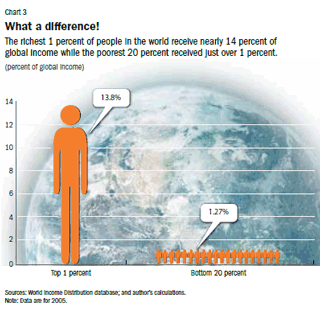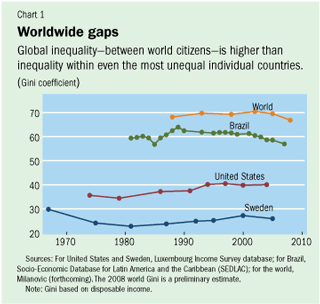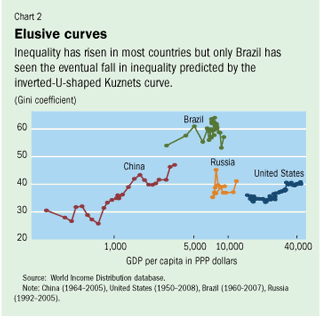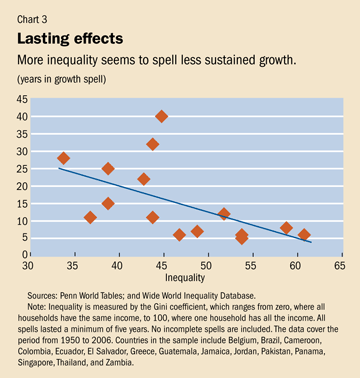This blog post is a collection of major points from the latest edition of Finance & Development magazine. It deals with inequality and its various dimension.

Global inequality is higher than inequality within nations, argues Branko Milanovic. The richest one percent of people in the world receive nearly 14 percent of global income while the poorest 20 percent receive just over one percent of global income. He argues that “global inequality seems to have declined from its high plateau of about 70 Gini points in 1990–2005 to about 67–68 points today.This is still much higher than inequality in any single country, and much higher than global inequality was 50 or 100 years ago.”

The rising inequality in both developed and developing countries is against the prediction of Kuznets upside-down “U” shaped curve and Heckscher-Ohlin-Samuelson (HOS) theorem. Kuznets argued that when everyone is poor inequality is very low. Then as people being to move form low productive agriculture to high productive non-agriculture sector, average income rises as wages also rise. This means as economy growth, inequality rises. But, economies grow richer, urban-rural gap is reduced and social security transfers (unemployment benefit, pension) lower income gap and hence inequality. The Hecksher-Ohlin-Samuelson theorem predicts that in international trade countries specialize on production of goods in which they have comparative advantage. The poor countries specialize in production of goods that requires low skill. This means demand for low skill goods rises as they cost less. Then wages of low-skilled workers increases relative to high-skilled workers. The narrowing gap between wages of different skill levels means that inequality is declining. But, are these evidence holding up now?
 Milanovic argues that Kuznets was right during the early days of the US (up until 1970s)and the UK (up until 1920s). But, inequality is rising now when average mean income is also rising. Similarly, inequality in poor countries is also rising, which is counter to HOS theorem.
Milanovic argues that Kuznets was right during the early days of the US (up until 1970s)and the UK (up until 1920s). But, inequality is rising now when average mean income is also rising. Similarly, inequality in poor countries is also rising, which is counter to HOS theorem.
[The Chinese case shows application of ‘Kuznetsian’ case, may be till the half part of the curve: Gini was 30 before 1978, i.e. when the country uniformly poor and before economic reforms. Then massive growth in coastal areas major manufacturing hubs and sectors led to increase in wages of the workers involved those sectors. Meantime, China also saw massive increase in economic growth. But, inequality is still rising and has surpassed the inequality prevalent in the US. Milanovic argues that Chinese government can help reduce inequality by extending social security to people outside the state sector or introduce unemployment benefits or, preferably, implement guaranteed rural employment scheme like NREGA in India.]
In 2010, real per capita income in the United States was 65 percent above its 1980s level and in the United Kingdom, 77 percent higher. Over the same period, inequality in the United States increased from about 35 to 40 or more Gini points (see Chart 1), and in the United Kingdom, from 30 to about 37 Gini points. These increases reflect significant adverse movements in income distributions. Overall, between the mid-1980s and the mid-2000s, inequality rose in 16 out of 20 rich OECD countries. This coincidence of rising mean income and rising inequality in mature economies would no doubt have surprised Kuznets, as it did many economists.
Inequality also rose in China, a poor country with comparative advantage in unskilled labor–intensive products, whose trade-to-GDP ratio jumped from about 20 percent to more than 60 percent in 2008. The HOS theorem of globalization predicts that inequality would have fallen as wages of low-skilled workers relative to skilled workers rose. In fact, however, China’s Gini coefficient rose from less than 30 in 1980 to about 45 today. Once again, fact confounds theory.
He identifies four potential causes of rise (stable in some countries) in inequality:
- technological progress (favored skilled workers, whose wages increased more)
- institutional change (higher taxes and social transfers—redistribution)
- changing social norms (society encourage high wages by skilled workers)
- globalization (specialization in high-skilled exports increases wages of the skill group)
He stresses that social transfers, unemployment benefits, guaranteed employment in rural areas like NREGA in India, social support programs such as Oportunidades in Mexico and Bolsa Familia in Brazil might help to reduce inequality. The decline in inequality in Brazil (from Gini of around 60 in 2000 to 57 today) can be attributed to social support programs, and broader access to education that increased the supply of skilled workers. Still, Brazil remains among the five most unequal countries in the world.
Berg and Ostry explore if there is a trade-off between equality and efficiency? They say NO, especially in the long term there is no trade-off between efficiency and equality.
In fact equality appears to be an important ingredient in promoting and sustaining growth. The difference between countries that can sustain rapid growth for many years or even decades and the many others that see growth spurts fade quickly may be the level of inequality. Countries may find that improving equality may also improve efficiency, understood as more sustainable long-run growth.
[…]inequality is strongly associated with less sustained growth. […]too much inequality might be destructive to growth. Beyond the risk that inequality may amplify the potential for financial crisis, it may also bring political instability, which can discourage investment. Inequality may make it harder for governments to make difficult but necessary choices in the face of shocks, such as raising taxes or cutting public spending to avoid a debt crisis. Or inequality may reflect poor people’s lack of access to financial services, which gives them fewer opportunities to invest in education and entrepreneurial activity.
[…]a 10 percentile decrease in inequality (represented by a change in the Gini coefficient from 40 to 37) increases the expected length of a growth spell by 50 percent. The effect is large, but is the sort of improvement that a number of countries have experienced during growth spells. We estimate that closing, say, half the inequality gap between Latin America and emerging Asia would more than double the expected duration of a growth spell in Latin America.
Kumhof and Ranciere argue that higher income inequality in development countries is associated with higher domestic and foreign indebtedness.
